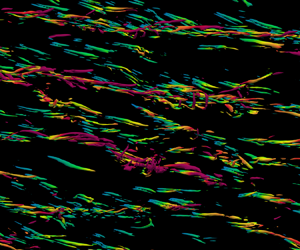Article contents
Multiscale dynamics in streamwise-rotating channel turbulence
Published online by Cambridge University Press: 29 September 2023
Abstract

In this paper the multiscale dynamics of streamwise-rotating channel turbulence is studied through direct numerical simulations. Using the generalized Kolmogorov equation, we find that as rotation becomes stronger, the turbulence in the buffer layer is obviously reduced by the intense spatial turbulent convection. On the contrary, in other layers, the turbulence is strengthened mainly by the modified production peak, the intense spatial turbulent convection and the suppressed forward energy cascades. It is also discovered that under a system rotation, small- and large-scale inclined structures have different angles with the streamwise direction, and the difference is strengthened with increasing rotation rates. The multiscale inclined structures are further confirmed quantitatively through a newly defined angle based on the velocity vector. Through the budget balance of Reynolds stresses and the hairpin vortex model, it is discovered that the Coriolis force and the pressure–velocity correlation are responsible for sustaining the inclined structures. The Coriolis force directly decreases the inclination angles but indirectly induces inclined structures in a more predominant way. The pressure–velocity correlation term is related to the strain rate tensor. Finally, the anisotropic generalized Kolmogorov equation is used to validate the above findings and reveals that the multiscale behaviours of the inclined structures are mainly induced by the mean spanwise velocity gradients.
JFM classification
Information
- Type
- JFM Papers
- Information
- Copyright
- © The Author(s), 2023. Published by Cambridge University Press
References
- 3
- Cited by


